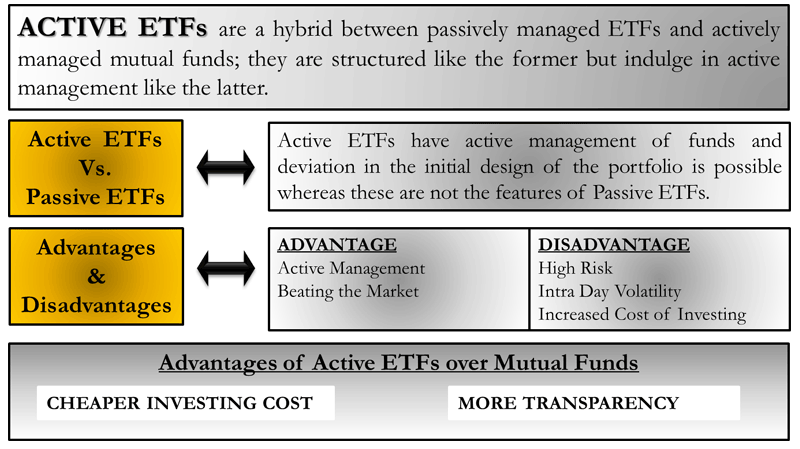Actively Managed Exchange Traded Funds, or Actively Managed ETFs, are cousins of Exchange Traded Funds. They share similar characteristics and are structured in the same manner as traditional, passively managed ETFs. These are a hybrid between passively managed ETFs and actively managed mutual funds; they are structured like the former but indulge in active management like the latter.
Difference between Active and Passive ETF Funds
Active Vs. Passive Management
The only difference is that while passive Exchange Traded Funds are designed to mimic an index focused on equities, fixed income, or is a blend of asset classes, Actively Managed ETFs intend to outperform their index by engaging the services of a portfolio manager.
Deviation in Portfolio Design
The manager reserves the authority to deviate from the index by making changes to the security-level or sector-level composition of the portfolio, given his views on markets and asset classes. Usually, the underlying index in Actively Managed ETFs is enhanced or uniquely positioned compared to market benchmarks. In contrast, it is not the case in passively managed ETFs.
The first actively managed ETF in the US was the Bear Stearns Current Yield ETF, launched in March 2008. It does not exist anymore, though.
Also Read: Exchange Traded Funds

Salient Features of Actively Managed ETFs
Actively Managed ETFs provide the same benefits that Exchange Traded Funds do. They are easily available as they are listed on securities exchanges and can be traded throughout the day via brokerage accounts. They are tax-efficient compared to mutual funds and are transparent. This is because Actively Managed ETFs disclose their holdings every day as they are traded on exchanges.
Advantages of Actively Managed ETFs
Active Management
The place where they score over traditional, passively managed ETFs is active management. In this sense, they act as a go-between passive ETFs and actively managed mutual funds. While assessing the tracking error is vital for a passively managed ETF, this is not the case with Actively Managed ETFs.
Beating Market Returns
For those investors who have already tested the waters of investing via passively managed ETFs, Actively Managed ETFs are a natural next step via which they can look at beating market returns.
But even after these advantages, Actively Managed ETFs are not free of flaws.
Disadvantages of Actively Managed ETFs
High Risk
Active management involves making bets on securities based on the fund management team’s view. But there are no guarantees that those views will result in benchmark index-beating results. Therefore, the risk is high. With passively managed Exchange Traded Funds, one is at least certain of benchmark returns minus the costs.
Also Read: Active vs Passive Portfolio Management
Intra Day Volatility
Pricing can also be a disadvantage. Though Actively Managed ETFs usually score over mutual funds because of their dynamic pricing, there can be situations during intra-day adverse market movement that an investor who intends to liquidate his holding may need to do so at a large discount to the Net Asset Value (NAV), which would not be the case with a mutual fund as all transactions are done at the NAV.
Cost of Investing
It is to be noted that while Actively Managed ETFs share the features of passively managed ETFs, they may be more expensive than the latter because the services of an investment team also act as an overhead, thus leading to an increase in cost.
Some of the properties of Actively Managed ETFs will be best elucidated once they are compared to that of actively managed mutual funds.
Actively Managed ETFs vs. Mutual Funds
Actively Managed ETFs as a product can be considered in-between passively managed ETFs and actively managed mutual funds. They provide the flexibility and ease of trade of the former while opening up the possibility of greater than index returns offered by the latter. To put it plainly, they are a hybrid between the two popular investment vehicles and management styles.
The intention of outperformance is what makes Actively Managed ETFs different from passively managed ETFs as far as investment philosophy is concerned. On the other hand, this property makes it comparable to a mutual fund.
Advantages of Active ETFs over Mutual Funds
Cheaper Investing Cost
There are some aspects, though, in which Actively Managed ETFs score over actively managed mutual funds. One of them is the cost. While Actively Managed ETFs, for the most part, are more expensive than passively managed ETFs due to active management services, they come out to be cheaper than most actively managed mutual funds because of the cost-benefit properties associated with ETFs specifically fund administration-related costs. When transacting with a mutual fund issuer, there are commission and record-keeping costs involved; these are absent from ETFs as they trade like any other exchange-listed security.
Transparency
Also, Actively Managed ETFs are more transparent than actively managed mutual funds because they need to disclose their holdings on a daily basis, while mutual funds can do so once a quarter. Further, Actively Managed ETFs are more dynamic as they are priced throughout the day, while mutual funds are priced once a day.
While investing in any exchange-traded product, it is important to look at the size and the trading volume of the fund; otherwise, liquidity issues can be faced.
Examples of Actively Managed ETFs
Fixed income funds dominate the Actively Managed ETFs space, with 8 of the top 10 largest funds investing in that asset class.
The largest Actively Managed ETF is the PIMCO Enhanced Short Maturity Active Exchange-Traded Fund (MINT), which has over $8 billion in assets. A distant second is the SPDR DoubleLine Total Return Tactical ETF (TOTL) with $3.5 billion in assets, followed by the First Trust Preferred Securities and Income ETF (FPE) with $3.4 billion in assets.

